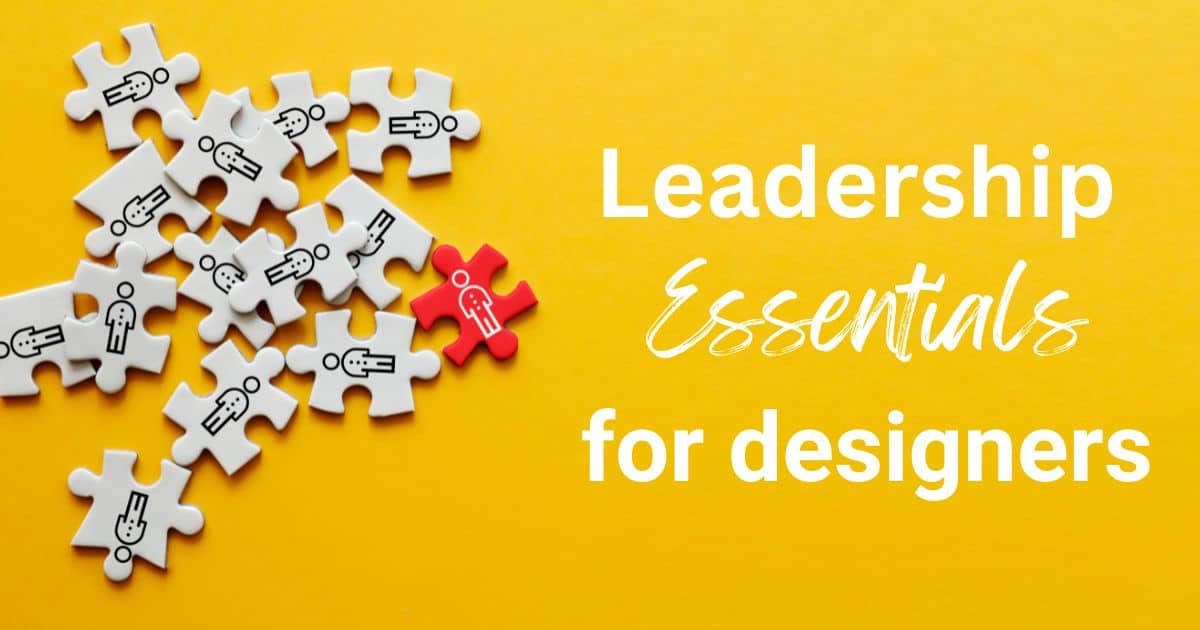Design teams don’t exist in a silo. They depend on other departments and functions to achieve success. Understanding the objectives of different stakeholders, as well as how they are aligned with the overall business strategy, is essential in creating designs that will make an impactful contribution to the bottom line.
This article shares insights from a recent Design Chats conversation with Jane Austin, Chief Experience Officer at Digitas UK, on how designers can collaborate with their colleagues to create products and services that align with the company’s objectives.
Why Design Should Start With Understanding Business Strategy
Design is not just about creating a great user experience but also about helping businesses unlock value by providing excellent customer service. And if you can’t unlock value, then a company isn’t going to continue to invest in that great experience.
Businesses make decisions based on return on investment, and design is no different. There is no point in designing something if it isn’t going to earn revenue.
By understanding how a business makes money, designers can anticipate different market forces and trends, better align their designs with the company’s sales and marketing strategies and create more competitive products and services. As a result, designers can advocate for their work because they can show tangible evidence of how it adds value to the company’s bottom line.
When you know your company’s future goals, competitors and potential for transformation with technology, it is possible to create harmony between business and user goals.
But if you haven’t studied the business strategy at your company, where do you start?
Here’s a checklist:
- Meet with the senior leaders or ask to be a guest at some of their strategy meetings.
- Talk with the marketing and sales teams.
- Read reports to gain a deeper understanding of the business model.
- Conduct internal research by treating colleagues as research subjects and asking for their insights on the business and customers.
- Learn about the technical limitations and capabilities of the teams at your organization so you’ll know if the beautiful interactions being designed can be built within those constraints.
Keep in mind that designers striving to move into the senior designer role must invest effort into understanding what people will pay for something and how much they would pay. When you’re a recent graduate of design school, you might be doing beautiful UI, but a senior designer knows why the UI matters and the trade-offs that need to be made.
Design wants a seat at the strategy table, but what that means is advocating for yourself and your practice by showing the impact on the bottom line for the company.\
How to Measure the ROI of Design
While it can be challenging to measure the ROI of design, you can discuss the impact of your design work on business value by utilizing both qualitative and quantitative data.
One effective way to do this is using objectives and key results (OKRs), a goal-setting framework that aligns the business goals with specific and measurable objectives. This means that designers should clearly understand what the business needs to achieve and use metrics to track progress toward these goals.
Here are a few approaches that can be used to measure the ROI of design:
- A/B testing: This involves creating two versions of a product or service, with one version using the new design and the other using the old design and then comparing the results. This can help to isolate the impact of the design changes on user engagement or conversion rates.
- Surveys and user research: Surveys and user research can help to gather qualitative data on how users interact with and perceive a product or service. This data can be used to gauge user satisfaction and identify areas for improvement.
- Financial metrics: Financial metrics such as revenue, profit, and customer lifetime value can be used to measure the impact of design on a company’s bottom line.
- Behavioral Metrics: Track the behavior of users like click-through rate, conversion rate, time on site, bounce rate, etc. to measure the impact of design on user engagement and task completion
- Comparison with industry benchmarks: Comparing a product’s or service’s performance with industry benchmarks can help gauge its relative success and identify areas for improvement.
You have to understand the reason behind design decisions and not make choices in isolation but instead in the context of the business objectives. This will make it more effective to argue for design decisions that will positively impact the business rather than just designing for aesthetics.
If a business is focused on acquisition, the key focus for the design team might be improving the signup flow because maybe that’s where you are losing the most people. Then you do experiments and work collaboratively to see if you can improve the signup flow.
Partnering with Data Teams
Collaborating with data teams within the organization can help designers gain a deeper understanding of customer behavior and improve the effectiveness of their design choices.
For example, they may have the tools to conduct more sophisticated A/B testing to inform you on what is and isn’t working.
The data team can also provide information on anomalies or segmentation that can be overlaid with qualitative data to gain a deeper understanding of user behavior. While data and metrics can provide a measure of past performance—known as lagging indicators—it’s also essential to understand user behavior and use this to form hypotheses and make predictions about future outcomes.
Design directors can often be in a position where they have to translate between the C-suite and the design and data teams. However, in an ideal situation, setting OKRs and translating strategy down the organization should be a collaborative effort between the C-suite, design and data teams.
The Cross-Functional Dream Team
The most effective team structure will vary depending on the project and the company. However, an ideal team structure would be conducive to collaboration, and effective communication where the OKRs and strategy are well-translated and understood by everyone.
Ideally, a product team should have a product manager, a designer, and a technical person working together. Additionally, it may be beneficial to have a design system or design director and a researcher to conduct discovery and ensure that the product is executed well.
The team should also have a design operations or product operations team to support the developers and provide an overall seamless experience. Overall, a classic squad setup with a focus on design, data and end-to-end experience is ideal.
The best teams have these qualities:
1. Trust and Autonomy
It’s essential to have a clear sense of autonomy and not just be told what to work on but to be empowered to decide how to achieve desired outcomes. The most important aspect of a team’s structure is whether or not they have control over their destiny.
A sign of a mature team is one that has end-to-end decision-making power, from deciding what to work on to delivering the final product. On the other hand, less mature teams may only be asked to execute someone else’s ideas without understanding the reasoning behind them.
Individuals and teams can mature by understanding the reasons behind their actions. Maturity in the product team is not only about the structure and communication of OKRs and metrics but also includes factors like trust, mutual understanding and psychological safety.
2. The Ability to Pivot
It’s also essential to have the ability to stop and pivot when things are not working, and this is often difficult as it may involve admitting failure, but it’s necessary to be able to move forward and create a better product. Companies have to create a culture that supports stopping or pivoting, and that doesn’t fear it.
3. Collaboration Over Competition
When a company culture is competitive and focused on stack ranking, it can create a culture where individuals focus on visibility and shipping code at the expense of other important considerations. This can lead to a lack of willingness to say no to projects and make it difficult for teams to collaborate effectively. In this kind of environment, to keep one’s job or to get promoted, employees may focus on short-term goals and not think about the long-term impact on the product and company.
While a certain level of competition can be healthy and drive innovation, when it becomes the central focus, it can lead to negative behaviors that are counterproductive to creating a successful product. If we take a look at the cutthroat and often ruthless world of competition, where it is necessary to stay above the bottom 10%, it’s easy to see that the stakes become incredibly high. This can often lead to a highly political atmosphere, with people growing increasingly anxious and stressed.
4. Meaning Before Perks
It’s also essential for employees to feel that they are part of something larger and that they find meaning in their work. This is a stronger driver of employee satisfaction than perks like pizza or sleeping pods. To drive success, companies need to create an environment that empowers and motivates employees to feel like they are making a difference, that fosters trust and safety, and encourages employees to find meaning in their work rather than relying on just perks.
Taking The Next Step in Your Design Career
Everyone should begin by getting a firm understanding of what truly makes them happy in their career. Exploring other roles, specializations and opportunities can help you find out which direction will be most fulfilling for you.If you’re pursuing a senior-level design role, it starts with understanding the fundamentals of business and how decisions are made.
No matter where you are in life, there is always something new to learn. Even if you’ve just graduated from university and landed your first job, learning should not stop there. Keep pushing yourself and stay on top of the latest trends. Set aside time each week or month dedicated solely to learning—whether reading articles online or taking an online course—so that you can continuously grow as a designer and professional. With enough effort and enthusiasm, there is no limit to how far your knowledge can take you.
Keep Learning with Business Strategy & Design
Enroll in Business Strategy & Design and learn how to confidently contribute to strategy conversations, measure and communicate the impact of your design work on business outcomes, align user-centered work with business objectives, and strengthen cross-functional partnerships.
Author
-

The Pragmatic Editorial Team comprises a diverse team of writers, researchers, and subject matter experts. We are trained to share Pragmatic Institute’s insights and useful information to guide product, data, and design professionals on their career development journeys. Pragmatic Institute is the global leader in Product, Data, and Design training and certification programs for working professionals. Since 1993, we’ve issued over 250,000 product management and product marketing certifications to professionals at companies around the globe. For questions or inquiries, please contact [email protected].
View all posts








